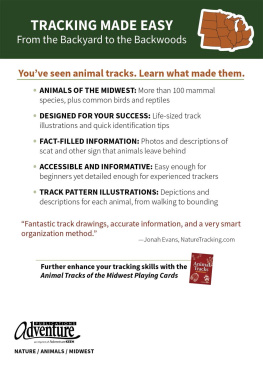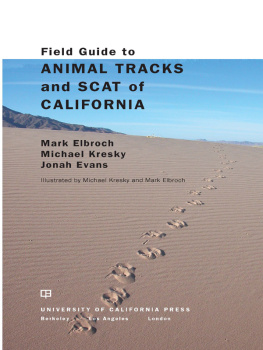About Tracking
Tracking is for everyone, beginner and expert, young and old. The fun of natures challenge is solving the mystery written in the trail. Prepare yourself by learning the background and basics of tracking before exercising your skills in the field.
Field Notes and Preserving Tracks
To the natural history detective, the track and trail are things of great beauty and significance. They tell part of the story of an animals life. Tracks and trails deserve to be preserved, both to increase your knowledge and as a record you can share with others. Preservation is commonly made in the form of written notes, casts, or photographs.
Perhaps the most important item in the naturalists tool kit is the field notebook. Field notes can jog the memory and facilitate better retention of knowledge. The notes can be analyzed later and can be preserved as records of chance encounters. Writing good field notes is an art form and a science in itself. Field notes are a source of pride when shown to others and may gain recognition for recording rare and unusual events. And need we mention how quickly memories, especially for details, fade when not preserved?
While great and complex systems have been designed for complete and accurate records, there are really but three requirements for the tracker: ruler, paper, and pen. With these, every trail becomes a record for later analysis and sharing. We cannot emphasize enough the importance of enhancing your tracking experience by keeping notes to which you can later refer!
A simple 3 5-inch notebook and a 6-inch ruler are adequate to get started. Use a pencil or a pen with ink that wont run if your notes get wet. To facilitate taking notes, ANW produces a waterproof notebook that contains information about footprint groups, gaits, and how to track and data sheets for recording information. English and metric rulers are imprinted on the back cover. See the introduction for ANW contact information.
Tracks may also be preserved by photographing and making casts. Good photographs can be made by any modern camera that can take a good close-up. When taking pictures, try to fill the viewfinder with the footprint; get as close as possible. Always include a ruler or some other object in the photo to provide a sense of scale. Avoid using hats, gloves, hands, or objects without a straight edge; round edges do not lend themselves to making accurate measurements from a photo. To avoid distortion, take the photograph from directly above the track, shooting straight down. Also, step back and take photographs of the trail to show the footprints that were photographed close-up.
Plaster casts are the old standby for preserving tracks. We suggest a casting kit that includes a 1-gallon (4-liter) plastic jar with a screw lid for carrying dry plaster, a narrow spatula, a plastic mixing cup such as those sold for medium-size drinks, paper for wrapping and transporting the finished cast, and a plastic sack for cleanup. A bottle of water may be needed if water is not available on-site. Two pounds of plaster will make at least four coyote-size track casts.
Purchase plaster from a lumberyard or hardware store, where prices will be more reasonable than at a drugstore or hobby shop. Almost any plaster will work, including plaster of paris, Hydrocal, Ultracal, or Hydrostone. Avoid getting plaster labeled Polyplaster or plaster for wallboard or patching compound, however. These plasters are formulated to be slightly flexible on walls and do not get hard enough for casts.
Two factors are critical to prevent casts from breaking: thickness and density. In the field, thickness is assured by building a wall around the track to contain the plaster. Natural objects such as twigs, stones, and dirt may be used to make a retaining wall 0.250.5 inch (0.61.3 cm) above the track. Alternatively, walls in the form of plastic strips cut from milk cartons or other plastic containers may be taken to the field. Proper density is assured by mixing two parts of plaster to one part of water by volume (read instructions on plaster container) to create a mixture similar in consistency to thick pancake batter or a milkshake.
Place your spatula close to the track and pour onto the spatula to break the fall of the plaster into the footprint. Working quickly, so the plaster does not set and become too thick, gently pour the plaster first into the fine detailed areas of the footprint and then the rest of the print. Finally, pour the plaster to an appropriate depth inside the retaining wall to keep the cast from breaking. Vibrating the spatula up and down across the top of the plaster will cause air bubbles to rise and the plaster to settle evenly, creating a smooth back for the cast.
Allow the plaster to dry for 30 minutes, or as long as is recommended on the plaster package. Gently pick up the plaster by digging your fingers under opposite sides of the cast, and turn the cast over onto one hand. Now wash off the dirt by rubbing the cast with your fingertips under the flowing water of a stream or a hose. Do not wash the cast in a sink as plaster may clog the drain. Let the cast continue to cure for several days in a warm, dry environment. If you need to transport it, wrap the cast in paper. Never wrap the cast in plastic; trapped moisture may cause it to crumble.
While special techniques are needed for casts made in dust and snow, the above procedure will allow casting in many situations. Remember, carry a plastic garbage bag and always clean up your mess. No sign of your plaster should remain to reduce the experience of others who happen by later.
Make Your Own Track Plates
Another method of preserving tracks is to use track plates. A track plate is a surface coated with a material that clings to the animals feet and leaves a minimum outline print on a collection board. Soot and chalk make good recording materials. (My book Track Plates for Mammals: A How-to Manual and Aid to Footprint Identification explains the many types and methods of making track plates.)
Make a low-cost, simple track plate box by cutting one end out of a small cardboard box. Fix a piece of clear contact paper, sticky side down, to the bottom of the box near the opening. Fix a second piece, sticky side up, to the back half using rings of tape. Place bait at the closed end of the box. Peanut butter is good bait for many animals.
To record the tracks, make a thin paste of carpenters chalk (available at hardware stores) mixed with rubbing alcohol and spread it onto the contact paper at the open end. As the alcohol evaporates, the chalk sticks to the paper and the powder will not blow away. The box is now ready.
When the animal walks across the chalk, the powder sticks to its feet. When the animal then steps on the sticky paper, great prints are recorded. Place a piece of blank paper onto the sticky paper and then remove it. The clear contact paper will show the footprints, which can then be copied.
Scats and Bird Pellets
Scats and bird pellets (also called cough pellets or castings) are often helpful for identifying an animal or completing the story thats written in the trail. Scats and pellets help identify not only what the animal was eating but also who the animal was. However, it should be noted that scats and pellets wont help you identify an animal with as much certainty as identification by tracks. Many animals make similar scats and pellets that are difficult to tell apart.
The scats of many carnivores are very similar, especially when the diet is mostly meat. Size alone does not provide a definitive answer because of the wide range of diameters produced within a species and even by a single member of a species. For example, foxes produce scats ranging in size from 0.3 to 0.8 inch (0.82 cm), coyotes produce scats 0.51.3 inches (1.33.3 cm), wolves produce scats 0.51.5 inches (1.33.8 cm), and we all know how our own scat varies in size and shape. When judging size, consider both the total quantity of scat and the size of individual pieces. Moist food produces slimmer scats, while fibrous diets produce wider scats.



